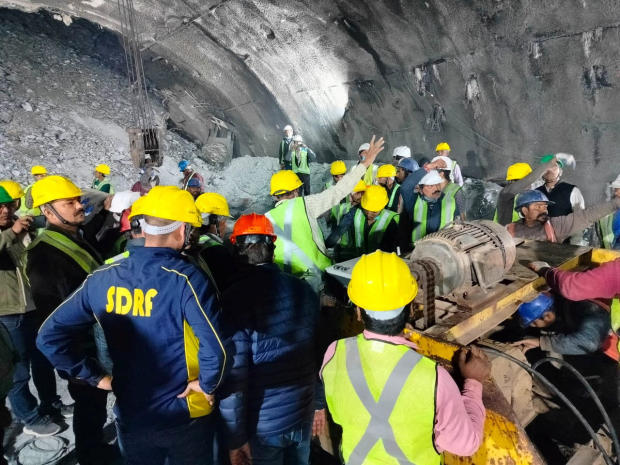Today Headlines Successful Rescue as “Rat Miners” Reach 41 Trapped Men After 17 Days in India Tunnel Collapse.
After 17 days of persistent efforts, rescuers successfully reached the 41 men who were trapped in a Himalayan highway tunnel in northern India on Tuesday. The breakthrough came from a team of skilled “rat miners” who manually excavated through the substantial debris that had accumulated in a section of the tunnel during a partial collapse on November 12.
These rat-hole miners, proficient in a traditional coal mining technique still prevalent in India, were enlisted on Monday after more than two weeks of unsuccessful attempts to reach the stranded workers using heavy machinery.

A group of 24 rat miners commenced their operation on Monday to manually drill through the debris pile, creating a narrow passageway to reach the trapped men.
Chief Minister Pushkar Singh Dhami, Uttarakhand’s top elected official, expressed appreciation for the tireless efforts of all the rescue teams involved in the operation. In a social media post, he praised the completion of the work to lay pipes in the tunnel for extracting the trapped workers, expressing optimism that all the laborers would soon be rescued.
As of Tuesday afternoon, ambulances and a medical team were stationed outside the tunnel entrance, ready to receive the workers for immediate medical examinations upon their extraction.
Rescuers had been attempting to drill through the collapsed tunnel’s debris using a large auger machine since the initial collapse, likely triggered by a landslide in the unstable Himalayan region. However, the machine became lodged in the rubble on Friday, necessitating its breakdown and removal—a process that itself spanned several days.
The 41 individuals have been stranded within an under-construction highway tunnel in the Silkyara district of Uttarakhand, northern India, following a collapse. Since the incident, rescuers drilled a small pipe into the tunnel on the first day, ensuring a supply of oxygen, food, and medicine for the trapped workers.
Recently, they successfully inserted a slightly wider pipe through the debris, allowing the delivery of hot meals and the deployment of a medical endoscopic camera. This development offered the world its initial glimpse into the condition of the men confined inside the tunnel.
“What does the term ‘rat-hole mining’ refer to?”
Rat-hole mining, an archaic and officially prohibited technique for manual coal extraction, involves the excavation of extremely narrow, vertical shafts into the ground. Miners descend into these pits using rudimentary tools such as pickaxes, shovels, and baskets, with no safety equipment and utilizing ropes or bamboo ladders.
The tunnels are typically only spacious enough for one miner at a time, prompting the inclusion of women and children among rat miners. Environmental experts argue that this method poses significant harm to the ecosystem, contributing to issues such as soil erosion, deforestation, acidification of rivers, and disruption of local ecosystems.
In 2014, India’s National Green Tribunal, a robust judicial entity dedicated to environmental preservation, prohibited rat-hole mining nationwide, citing its adverse environmental effects and hazardous working conditions. However, the practice persists in certain regions of India, as viable alternative sources of livelihood for local communities are lacking.
